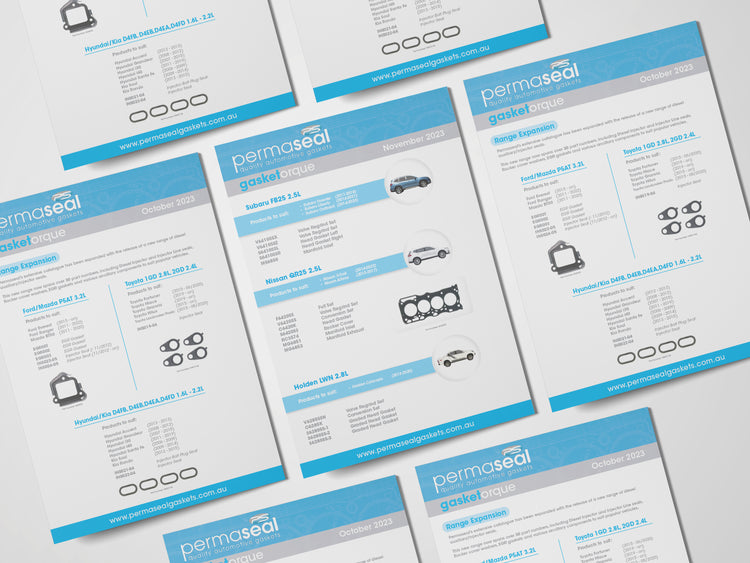
Oil Seals
Oil seals in an automotive environment perform two main functions; retain the engines lubricant within the engine and exclude outside contaminants, such as dirt and dust from entering the engine. In order to perform these functions, there are four key components that make up the Oil Seal Concept. The shaft, on which the oil seal must run; the bore, in which the oil seal is housed; the conditions, in which the oil seal must operate and the oil seal itself.
When a radial lip oil seal is operating correctly, the sealing lip does not actually come in contact with the surface of the shaft. The difference in internal and external engine pressures allows a very thin film of oil to seep between the seal lip and the shaft. It is on this film of oil that the sealing lip runs. If the load provided by the oil seals garter spring and the internal pressure of the seals elastomer (rubber) are correct, then the film of oil is maintained and oil is prevented from leaking past the sealing lip.
An incorrect balance of engine pressures and seal load will allow either too much oil through, causing the seal to leak, or too little oil through, resulting in excessive lip wear and eventual leakage.
Standard Design Types
In most automotive applications, radial lip oil seals fall into one of two main design categories. The table across illustrates the differences between S Lip and T Lip design oil seals.

|
Variations on standard seal design types include the addition of hydrodynamic sealing lips, which have helical ribs or helix lines which help pump oil back under the sealing lip. Hydrodynamic sealing lips can be mono-directional or bi-directional. Other variations include flange style casings and special synthetic fabric dust lips. These variations are identified by the use letter which prefix and or suffix the standard design code i.e.: TC is a rubber cased, single lip oil seal, with an auxiliary dust lip. HTCKL is a rubber cased, single lip oil seal with mono directional helix lines for a left-hand rotation, with a special synthetic fabric dust seal.
Materials
One of the most important components of the radial lip oil seal is the elastomer material used in the seals construction. There are many different classes of elastomer blends specially developed to meet a wide variety of sealing requirements, each with an individual formula to satisfy various sealing conditions. Many of these blends use a base polymer from one of the four main groups listed below.
Nitrile, commonly known as Buna-N is the most common base polymer used in fluid sealing. Nitrile has very good resistance to the swelling effects of petroleum-based products. Generally, when a nitrile seal fails in service, it is because it has been subjected to temperatures outside of its recommended limits or to chemicals that have a degrading effect on nitrile. The result is hardening and eventual embrittlement.
Polyacrylate is used in applications where a higher temperature resistance is required. Polyacrylate has very good resistance to the swelling effects of petroleum-based products and its resistance to the decomposition products of extreme pressure gear oil additives.
Silicone functions satisfactorily over a very wide temperature range and at extreme temperatures silicone is superior. With excellent resistance to compression set, the main application for silicone is crankshaft seals. In comparison to other elastomers used in the manufacturing of oil seals silicone, has a very poor resistance to abrasion.
Fluoro elastomer common trade names include Viton, Technoflon and Fluorel. Has very good heat resistance and swelling in highly aromatic fuels is low. Certain oil additives can cause embrittlement at relatively low temperatures. Fluoroelastomers have a very good resistance to abrasion.
A Special Caution on Fluoroelastomers
Fluoroelastomer is a synthetic material containing fluorine used for gaskets, o rings and seals. When used within design specifications it is completely safe, however, if exposed to high temperatures the material decomposes and one of the by-products formed is hydrofluoric acid. This acid is extremely corrosive and is almost impossible to remove, especially from human tissue. When inspecting equipment which has been exposed to high temperatures, check if any gaskets, o rings or seals have suffered from decomposition, which will appear as charred or black and sticky. DO NOT under any circumstances touch either the seal or the area containing the seal, until a substantial cooling period has been allowed. The affected area should be decontaminated before undertaking any further work.
Note: Viton is the registered trade mark of Du Pont Inc.,Technoflon is the registered trade mark of Montecatini Spa., Fluorel is the registered trade mark of Minnesota Mining & Manufacturing Ltd.


